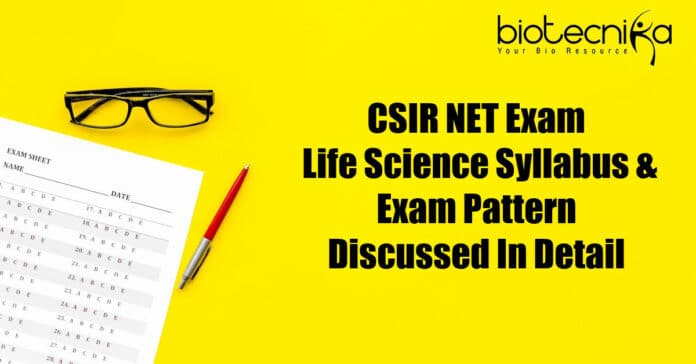CSIR NET Exam Syllabus For Life Science 2023
Council of Scientific & Industrial Research-National Eligibility Test or CSIR NET is a standard examination conducted nationwide for ascertaining the aptitude of Indian nationals for LS/AP (Lectureship/Assistant Professor) and JRF (Junior Research Fellowship). Previously the National Eligibility Test was conducted separately as UGC NET (University Grants Commission-NET) & CSIR NET. Now, it is held as Joint CSIR-UGC NET examination by NTA (National Testing Agency) on behalf of CSIR. This exam is applicable only for bonafide Indian nationals. The exam score is accepted by colleges, universities, and research institutes in both the private & public sectors all around India in addition to meeting the eligibility norms put up by UGC.
Quick CSIR NET Exam Details
| Exam Title | Joint CSIR-UGC NET |
| Frequency of Exam | Twice a year |
| Exam Months (Usual) | June & December |
| Mode of Exam | CBT (Computer Based Test) |
| Question Type | MCQ (Multiple Choice Questions) |
| Time | 3 hours |
| Medium | Hindi or English |
| Total Marks | 200 |
| Reference Site | CSIR NET Official Site |
Science-based candidates looking for JRF or LS/AP can apply for this exam. CSIR NET is conducted in five different subjects throughout the country, which are:
- Mathematical Sciences
- Earth Sciences
- Chemical Sciences
- Physical Sciences
- Life Sciences
Life Science is an area of study concerned with the technical understanding of biotechnology & biology that offers a chance to learn each and every fact and detail regarding human beings, microbes, plants, and, animals. If you are wishing to advance your career in research or teaching after M.Sc. in Science or allied subjects, CSIR NET is the key to your future.
Exam Pattern & Syllabus For CSIR NET Life Science
Students wishing to write the CSIR NET 2021 exam to tune their career for research or teaching disciplines should be aware of the exam pattern and syllabus for the CSIR NET exam. It is crucial to have a thorough understanding of the syllabus to get an idea of the sections asked for the examination. Along with that exam pattern facilitates easy preparation for the CSIR NET exam. Therefore to solely focus and study for the exam, it is significant to possess the whole information package. This article enlists and explains all the requisites for CSIR NET 2021 exam pattern & syllabus for life sciences. CSIR NET applicants should note that the exam pattern and syllabus stated below are from CSIR NET 2020. If there is any change in the pattern and syllabus, it will be updated.
I. CSIR NET 2021 Life Science Exam Pattern
This national level exam is a single paper test sectioned into three parts: Part A, B & C.
- Part A: This section is the same for all subjects of the CSIR NET exam. Here, your eligibility is determined with research aptitude, quantitative reasoning & analysis, and general science skills.
- Part B: This part involves general questions mostly from topics provided in the CSIR NET life science syllabus.
- Part C: This section ascertains the student’s proficiency in scientific theories and their applications. The paper shall be of an analytical type wherein the student is anticipated to apply the theoretical concepts to find an answer to the scientific question.
| Paper Sections | Total Questions Provided | Number Of Questions To Be Answered | Marks For Each Section | Negative Marking For Each Section | Total Time |
| Part A | 20 | 15 | 30 | 0.5 | 3hours |
| Part B | 50 | 35 | 70 | 0.5 | |
| Part C | 75 | 25 | 100 | 1 | |
| Total Marks | 200 | ||||
NOTE: If the student answers more than required, only the initial required number of answers will be considered.
II. CSIR NET 2021 Syllabus For Life Science
CSIR NET test paper has both general aptitude and life science-related questions. The paper is categorized accordingly as mentioned in the order above.
1. General Aptitude
General aptitude is the same for all subjects in the CSIR NET exam. It mainly covers three areas: Graphical analysis & data interpretation, reasoning, and numerical ability.
a. Graphical Analysis & Data Interpretation – Tabulation, Pie-Chart, Graphical analysis: Line & bar graph, measures of dispersion, mode, median, and mean.
b. Reasoning – Puzzles, Ranking & arrangement, Clock & calendar, Directions & distance, coding-decoding, series formation, and so on.
c. Numerical Ability – Trigonometry, Mensuration, Geometry, Probability, Permutation & combinations, Time & Work, Time speed & distance, Mixture & Alligation, partnership, Proportion & variation, Ratio, Compound interest, Simple interest, Profit & loss, Percentage, Logarithms, Surds & Indices, Sequence & Series, Quadratic equations, HCF & LCM average, Number & Simplification, and so on.
2. CSIR NET Life Science Syllabus – Topics
There are thirteen units under CSIR NET Life Science. Detailed contents from each unit are described below.
| Unit | Topic Name |
| 1 | Molecules and their Interaction Relevant to Biology |
| 2 | Cellular Organization |
| 3 | Fundamental Processes |
| 4 | Cell Communication and Cell Signaling |
| 5 | Developmental Biology |
| 6 | System Physiology – Plant |
| 7 | System Physiology – Animal |
| 8 | Inheritance Biology |
| 9 | Diversity of Life Forms |
| 10 | Ecological Principles |
| 11 | Evolution and Behavior |
| 12 | Applied Biology |
| 13 | Methods in Biology |
CSIR NET Life Science 2021 Exam Syllabus For
Unit 13 – Methods in Biology
i) Methods in Field Biology: Habitual characterization: remote & ground sensing methods, sampling methods within the behavior study, ranging patterns- remote; indirect; and direct observations, and population density estimation methods of plants & animals.
ii) Electrophysiological Methods: CAT, fMRI, MRI, PET, pharmacological testing, brain stimulation & lesions, brain activity recording, ECG, patch-clamp recording, and single-neutron recording.
iii) Microscopic Techniques: Microscopical image processing methods, freeze-fracture & freeze-etch EM methods, EM staining & fixation techniques, transmission & scanning microscopes, living cell microscopy, resolving powers of various microscopes, and subcellular and cellular component visualization with light microscopy.
iv) Radiolabeling Techniques: Safety guidelines, radioactive material’s molecular imaging, the addition of radioisotopes within biological cells & tissues, and measurement & detection of various kinds of radioisotopes commonly employed in biology.
v) Statistical Methods: Basic introduction to multivariate statistics, X2 test, analysis of variance, t-test, correlation & regression, levels of significance, errors, confidence interval, comparison of parametric & non-parametric statistics, sampling distribution, probability distributions, measures of dispersal & central tendency, and so on.
vi) Biophysical Method: Surface plasma resonance methods, mass spectrometry types, light scattering mediated molecular analysis, NMR & X-Ray diffraction mediated molecular structure determination, ESR, NMR, circular dichroism, fluorescence, UV/visible spectroscopy mediated molecular analysis.
vii) Immuno & Histochemical Techniques: GISH & FISH based in situ localization, detection of molecules within living cells, immunofluorescence microscopy, flow cytometry, immunoprecipitation, western blot, RIA, and ELISA based molecule detection, and antibody generation.
viii) Recombinant DNA & Molecular Biology Methods: Isolation & analysis of lipid & carbohydrate molecules-AFLP, RAPD, and RFLP techniques, large scale expression- microarray-based techniques, gene expression analysis at protein & RNA level, strategies of genome sequencing, DNA sequencing methods, protein’s post-translational modification detection, protein sequencing methods, eukaryotic & bacterial gene knock-out, in vitro deletion & mutagenesis techniques, BAC & YAC, cosmid, phage, and plasmid vector-mediated generation of cDNA and genomic libraries, specific nucleic acid sequence isolation, plant, animal, and bacterial vector-based recombinant protein expression, eukaryotic & bacterial molecular cloning of RNA or DNA fragments, isoelectric focusing gels, 2 and 1-D gel electrophoresis-based protein, DNA, and RNA analysis, separation methods for protein, DNA (plasmid & genomic), and RNA.
Unit 12 – Applied Biology
i) Biosensors
ii) Phytoremediation & Bioremediation
iii) Biodiversity Uses & Bioresources
iv) Breeding in Animals & Plants like Marker-Assisted Selection
v) Genomics & its Applications in Agriculture & Health like Gene Therapy
vi) Molecular Approached to Identify Strain & Diagnose, transgenic plants & animals
vii) Cell & Tissue Culture Methods for Animals & Plants, Application of diagnostics, vaccines, immunological principles
viii) Production of macro & small molecules and microbial fermentation
Check Out Biotecnika’s CSIR NET Learning Platform
Unit 11 – Evolution & Behaviour
i) Evolution, Behaviour & Brain: Behavioral & domestication changes, navigation & orientation, optimality & habitat selection in foraging, aggressive behavior, parental care, reproductive success & parental investment, mating systems, use of territoriality & space, social dominance, social communication, behavior development, biological clocks, arousal & sleep, cognition, memory, the neural basis of learning, evolution & altruism-reciprocal altruism, kin selection, and group selection, ultimate & proximate causation, methods & approaches in behavior study.
ii) Mechanisms: Co-evolution, sexual selection, convergent evolution, sympatric & allopatric, speciation, isolating mechanisms, adaptive radiation, random genetic drift & migration, natural selection mediated gene frequency change concepts and rates, Hardy-Weinberg Law, gene frequency, gene pool, populations.
iii) Molecular Evolution: gene divergence & duplication, the origin of new proteins & genes, nucleotide & protein sequence analysis, molecular tools in identification; classification & phylogeny, molecular clocks & divergence, neutral evolution concepts.
iv) Evolutionary History & Paleontology: Primate evolution stages, major groups of animals & plants, origins of multicellular & unicellular organisms, major occurrences in the evolutionary period, epoch, periods & eras, evolutionary time scale.
v) Origins of Unicellular & Cellular Evolution: aerobic & anaerobic metabolism, photosynthesis, the evolution of unicellular eukaryotes, the origin of eukaryotic cells, the evolution of prokaryotes, the first cell, Miller’s experiment, Haldane & Oparin’s concept, abiotic synthesis of organic polymers and monomers, the origin of fundamental biomolecules.
vi) Emergence of Evolutionary Thoughts: The evolutionary synthesis, spontaneity of mutations, Mendelism, natural selection & fitness, struggle, adaptation, Variation in Darwin’s & Lamarck’s concepts.
CSIR NET Life Science 2021 Exam Syllabus For
Unit 10 – Ecological Principles
i) Conservation Biology: Management strategy/Indian conservation case studies, major management approaches, conservation principles
ii) Applied Ecology: Biodiversity management methods, major biodiversity changing aspects, Biodiversity-documentation; monitoring & status, global environmental change, environmental pollution.
iii) Biogeography: Biogeographical zones in India, island biogeography theory, major terrestrial biomes.
iv) Ecosystem Ecology: Function & structure of few Indian ecosystems: aquatic & terrestrial, decomposition & primary production, mineral cycling & energy flow, ecosystem function & structure.
v) Ecological Succession: the concept of climax, alteration in succession, mechanism, types.
vi) Community Ecology: Ecotones & edges, species diversity levels & its measurements, community attributes & structure, nature of communities.
vii) Species Interactions: Symbiosis, pollination, carnivory, herbivory, interspecific competition, interaction types.
viii) Population Ecology: Age structure populations, interdemic extinctions, metapopulation concept- dispersal & demes, life history strategies, population regulation, population growth curves, population characteristics.
ix) Habitat and Niche: Character displacement, resource partitioning, realized & fundamental niche, overlap & niche width, the concept of niche & habitat.
x) The Environment: Abiotic & biotic interactions, biotic environment, physical environment.
Unit 9 – Diversity of Life Forms
i) Organisms of Conservation Concern: Conservation strategies, endangered & rare species.
ii) Organisms of Agricultural & Health Importance: Common pathogen and parasites of crops, domestic animals, and humans.
iii) Natural History of Indian Subcontinent: Phenology & seasonality of subcontinent, common Indian mammals, migrations of species, geographic origins, major types of habitat in the subcontinent.
iv) Outline Classification of Microbes, Animals & Plants: Evolutionary relationships within taxa, classification of microbes, animals, and plants, important criteria employed for categorization in each taxon.
v)Levels of Structural Organization: Adaptive modifications, adaptive radiation, comparative anatomy, organization levels of systems, organs & tissues, multicellular, colonial & unicellular forms.
vi) Principles & Methods of Taxonomy: Quantitative & classical methods of the taxonomy of microbes, animals, and plants, biological nomenclature, hierarchical taxa & concepts of species.
MUST-READ ARTICLES:
-
10 Points On How An Average Student Can Also Qualify CSIR NET Exam
-
CSIR NET 2020 Exam Question Paper Analysis – Download Solved Question Paper + Planner
-
50 CSIR NET Trap Questions Example – You Must Never Attempt These In Exam!
-
How & What To Study From CSIR NET Previous Year Question Papers
Unit 8 – Inheritance Biology
i) Recombination: Non-homologous & homologous recombination
ii) Numerical & Structural Alterations of Chromosomes: Ploidy & their genetic implications, translocation, inversion, duplication, and deletion.
iii) Mutation: Insertional mutagenesis, somatic versus germinal mutants, the gain & loss of function, biochemical, conditional, and lethal, detection, causes.
iv) Quantitative Genetics: QTL mapping, heritability & its measurements, polygenic inheritance.
v) Human Genetics: Genetic disorders, karyotypes, LOD score for linkage testing, pedigree analysis.
vi) Microbial genetics: Genetic transfer methods: Fine structure analysis of genes, interrupted mating mediated gene mapping, sex-duction & transduction, conjugation, transformation.
vii) Extra Chromosomal Inheritance: Maternal inheritance, the inheritance of chloroplast & mitochondrial genes.
viii) Gene Mapping Methods: Plant population mapping development, somatic cell hybrid mediated mapping, molecular markers mediated mapping, tetrad analysis, linkage maps.
ix) Extensions of Mendelian Principles: Sex influenced & limited characters, sex linkage, crossing over & linkage, phenocopy, expressivity & penetrance, genomic imprinting, pleiotropy, gene interactions, incomplete dominance, codominance.
x) Concept of Gene: Complementation tests, pseudoallele, multiple alleles, allele.
xi) Mendelian Principles: Independent assortment, segregation, dominance.
Unit 7 – System Physiology-Animal
i) Reproduction & Endocrinology: Neuroendocrine regulation, ovulation, gametogenesis, reproductive processes, diseases & hormones, the fundamental mechanism of hormone action, endocrine glands.
ii) Digestive System: BMR, energy balance, absorption, digestion
iii) Adaptation & Stress
iv) Thermoregulation: acclimatization, neural, chemical & physical regulation.
v) Excretory System: Aid-base balance, electrolyte balance, blood pressure, blood volume, regulation of water balance, micturition, waste elimination, urine concentration.
vi) Sense Organs: Tactile response, hearing, and vision.
vii) Nervous System: Neural control of posture & muscle tone, peripheral & central NS, gross neuroanatomy of spinal cord & brain, action potential, neurons.
viii) Respiratory System: Chemical & neural respiration regulation, waste elimination, gas exchange, gas transport, anatomical considerations, comparison of respiration in distinct species.
ix) Cardiovascular System: Chemical & neural regulation, blood pressure, heart as a pump, cardiac cycle, ECG- its significance & principles, specialized tissue, myogenic heart, comparative anatomy of the heart structure.
x) Blood & circulation: Hemostasis, immunity, hemoglobin, blood groups, blood volume regulation, blood volume, plasma function, formed elements & hemopoiesis, blood corpuscles.
Unit 6 – System Physiology-Plant
i) Stress Physiology: Plant responses to abiotic & biotic stresses.
ii) Secondary metabolites: Biosynthesis of nitrogenous compounds, phenols, and terpenes & their roles.
iii) Solute Transport & Photoassimilate Translocation: Mechanisms of unloading & loading of photoassimilates, transpiration, translocation, transport & uptake of macromolecules, solutes & ions via phloem & xylem, across membranes, and through cells.
iv) Sensory Photobiology: Biological clocks, photoperiodism, stomatal movement, mechanism of action, function & structure of phytochromes, phototropin & cryptochromes.
v) Plant Hormones: Mechanism of action & physiological effects, transport & breakdown, storage, biosynthesis.
vi) Nitrogen Metabolism: Amino acid biosynthesis, ammonium & nitrate assimilation.
vii) Respiration & Photorespiration: Photo respiratory pathway, alternate oxidase, ATP synthesis & plant mitochondrial electron transport, citric acid cycle.
viii) Photosynthesis: CO2 fixation-CAM, C4, and C3 pathways, photoprotective mechanisms, mechanisms of electron transport, light-harvesting complexes.
Unit 5 – Developmental Biology
i) Programmed Senescence, Aging & Cell Death.
ii) Morphogenesis & Organogenesis In Plants: Floral & meristem development in Antirrhinum & Arabidopsis, the transition to flowering, phyllotaxy & leaf development, root & shoot development, organization of root & shoot apical meristem.
iii) Morphogenesis & Organogenesis In Animals: Sex determination, environmental regulation of the normal development, post-embryonic development- metamorphosis, larval formation, differentiation of neurons, organogenesis- limb regeneration & development in vertebrates, eye lens induction, vulva formation in Caenorhabditis elegans, pattern & axes formation in chick, amphibian, and Drosophila, cell differentiation & aggregation in Dictyostelium.
iv) Gametogenesis, Fertilization & Early Development: Seed germination & formation, the establishment of symmetry in plants, embryogenesis, germ layer formation & gastrulation in animals, embryonic fields, blastula formation, cleavage, zygote formation, double fertilization & embryo sac development in plants, cell surface compound in the sperm-egg recognition in animals, production of gametes.
v) Basic Concepts of Development: Transgenics & mutants in the analysis of development, imprinting, cytoplasmic determinants & genomic equivalence, stem cells, cell lineages & fate, morphogenetic gradients, differentiation & determination, competence, induction, specification, commitment, potency.
CSIR NET Life Science 2021 Exam Syllabus For
Unit 4 – Cell Communication & Signaling
i) Innate & Adaptive Immune System: Vaccines, acquired & congenital immunodeficiencies, immune response during viral, parasitic & bacterial infections, autoimmunity & hypersensitivity, inflammations, cell-mediated effector functions, toll-like receptors, complement system, secondary & primary immune modulation, cell-mediated & humoral immune response, T& B cell receptors, differentiation & activation of B7 T cells, antigen presentation & processing, MHC molecules, antigen-antibody reactions, antibody engineering, monoclonal antibodies, generation of antibody diversity, function & structure of antibody molecules, T & B cell epitopes, immunogenicity & antigenicity, antigens, molecules & cells involved in adaptive & innate immunity.
ii) Cancer: Treatment of uncontrolled cell growth, apoptosis, the interaction of normal & cancer cells, metastasis, virus-induced cancer, cell cycle & cancer, tumor suppressor genes, oncogenes, genetic rearrangements within progenitor cells.
iii) Cellular communication: Neurotransmission & its regulation, integrins, extracellular matrix, gap junctions, roles of cell adhesion molecules and types, the general principle of cell communication, hematopoiesis regulation.
iv) Cell Signaling: Quorum sensing, bacterial chemotaxis, light signaling in plants, plant & bacterial two-component systems, regulation of signaling pathways, second messengers, signal transduction pathways, G-protein couple receptors mediated signaling, cell surface receptors, hormones & their receptors.
v) Host-Parasite Interaction: Cell-cell fusion in both abnormal & normal cells, pathogen-induced diseases in plants & animals, modification of host cell behavior with pathogens, entry & recognition of various pathogens such as viruses & bacteria into plant & animal host cells.
Unit 3 – Fundamental Process
i) Control of Gene Expression At Transcription & Translation Level: Chromatin’s role in gene silencing & expression, regulating the expression of eukaryotic & prokaryotic, viruses, and phage genes.
ii) Protein Synthesis & Processing: Post-translational modification of proteins, translational inhibitors, translational proof-reading, aminoacyl tRNA synthetase, tRNA-identity, aminoacylation of tRNA, genetic code, termination, elongation factors, initiation factors & regulation, initiation complex formation, the ribosome.
iii) RNA Synthesis & Processing: Function & structure of various kinds of RNA transport & RNA, polyadenylation, splicing, RNA editing, RNA processing, termination, elongation, capping, RNA polymerases, transcription repressor & activator, the formation of initiation complex, transcription machinery & factors.
iv)DNA Replication, Repair & Recombination: Site-specific & homologous recombination, DNA repair mechanisms, extrachromosomal replicons, fidelity of replication, replication fork and origin, enzymes involved, unit of replication.
Unit 2 – Cellular Organization
i) Microbial Physiology: Stress response, strategies of cell division, growth characteristics & yield.
ii) Cell Division & Cell Cycle: Control & regulation of cell cycle, steps in cell cycle, meiosis & mitosis & their regulation.
iii) Organization of Genes & Chromosomes: Transposons, euchromatin, heterochromatin, the structure of chromosomes & chromatin, gene families, interrupted genes, repetitive & unique DNA, operon.
iv) Structural Organization & Function of Intracellular Organelles: Function & structure of cytoskeleton & its role in motility, chloroplast, vacuoles, plastids, peroxisomes, endoplasmic reticulum, lysosomes, Golgi bodies, mitochondria, nucleus, cell wall.
v) Membrane Structure & Function: Electrical properties of membranes, regulation of intracellular transport, mechanism of sorting, membrane pumps, active transport, ion channels, osmosis, membrane & lipid bilayer protein diffusion, the structure of the model membrane.
CSIR NET Life Science 2021 Exam Syllabus For
Unit -1 Molecules & Their Interaction Relevant to Biology
i) Metabolism of Vitamins, Nucleotides, Amino acids, Lipids, Carbohydrates.
ii) Stability of Proteins & Nucleic Acids.
iii) Conformation of Nucleic Acids.
iv) Conformation of Proteins
v) Principles of Isozymes, Mechanism of Enzyme Catalysis, Enzyme Regulation, Enzyme & Enzyme Kinetics, Catalysis.
vi) Biological Energy Transducers, Group Transfer, Coupled Reaction, Oxidative Phosphorylation, Glycolysis, Bioenergetics.
vii) Principles of Biophysical Chemistry
viii) Stabilizing Interactions
ix) Function, Structure & Composition of Biomolecules
x) Structure of Chemical Bonds, Molecules & Atoms.
CSIR NET 2021 Syllabus, CSIR NET, 2021 Syllabus, CSIR NET 2021, Syllabus
DOWNLOAD CSIR NET LIFE SCIENCE 2023 EXAM SYLLABUS
How To Study From CSIR NET Life Science Syllabus For 2021 Exam?
- Categorize Units based on your difficulty level and their importance in the CSIR NET Life science exam
- Design an effective Unit wise Study Time Table Accordingly
- Start with units that you feel is easier for you to understand
- Slowly move to other units based on the number of questions asked from them in the CSIR past year NET Exam – refer to previous year question papers to plan this.
- Make a list of important topics from the syllabus from each unit and prepare them first
- After Each unit, do a revision & attempt a Mock test, Biotecnika provides unit wise tests for more details call Toll FREE – 1800-1200-1818.
In order to practice the above points strictly, you need to start your CSIR NET life science exam preparation well in advance & be mentally Prepared that you are definitely going to crack the exam this time with a high rank.
Unique Products Offered by Biotecnika That Will Help You Qualify The CSIR NET Life Science Exam, Check Them Out Below:
- Jumbo Combo Course for CSIR NET & GATE
- CSIR NET Koncept Wheel Book
- Konceptika Lite – 100 Flowcharts on 100 Important topics of CSIR NET Exam
- Koncept Cloud – Latest Study Tool Revolutionizing CSIR NET Revisions
- CSIR NET Quick NET Revisor 2023 (QNR 2023)
- ToughNet Question Bank
- BioTecNika e-Learner 2023










































